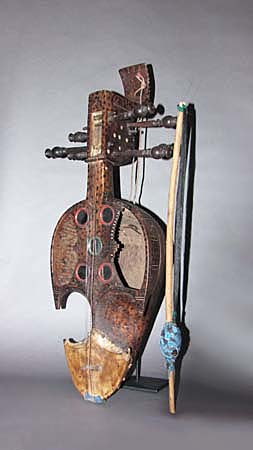
Owner: HWMC
Catalogue #: AS-CHLT-09-14
Lutes
India ‘Surando’ (Sarinda)
India, Pakistan
Indian
Wood, metal strings, gut string, hide, horsehair, mirror, cloth
Mid 19th century
Chordophones – Lutes
This surando known in Kutch (a district of Gujarate state in western India), is an ancient folk fiddle that is played with a horsehair strung bow, called a gaz or gazi in local dialect. It is carved from wood in the shape of a heart with a rounded back and deeply waisted sides towards the front. The bottom part of the front hollow wooden soundbox is covered with animal skin and the upper part of the chambered body has applied mirror decoration in the center. The number of strings can vary from six to thirteen strings, however, the most common are eight, which is represented here. There are three bowed strings, two drone strings and the remaining sympathetic strings. All the strings are made of steel except for the first drone string (saggo), which is the second string from the left. It is referred to as ‘the queen string’ and is the key string which is made out of sheep gut. The peghead is bent back above an open box with the eight bilateral pegs. It is played while sitting on the ground in a vertical orientation.
The surando is believed to have been well known as sarinda in northern parts of India and in Sind of Pakistan. The name surando is based on ‘surayindah’, a Persian word for one who produces tunes. In the Frontier region of Pakistan, this instrument is called saro, while in Balochistan it is called saroz
Resource: ‘ Surando,’ Alastair Dick,”The Grove Dictionary of Musical Instruments,” 2nd ed., Vol. 4, Laurence Libin, Editor in Chief. Oxford University Press.
